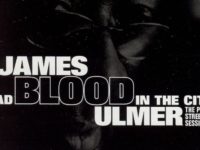Vernon Reid has a busy 2012 on tap, with a new jazz-rock collaboration as a part of Spectrum Road to be issued next month and then the latest project with the metal-funk band Living Colour. He took a quick break to discuss a few favorite songs on this special edition of Gimme Five — including Living Colour’s signature moment, “Cult of Personality.”
Elsewhere, Reid shares insight into collaborations with avant-garde bluesman James “Blood” Ulmer and legendary jazz producer Teo Macero. He also takes us into the creative process behind two of the new songs from Spectrum Road, which also features Jack Bruce (Cream), John Medeski (Medeski Martin and Wood) and Cindy Blackman-Santana (Lenny Kravitz).
The quartet will play Bonnaroo on June 9, 2012, just a few days after the self-titled Spectrum Road is set for release by Palmetto Records. Additional dates at the Playboy and North Sea jazz festivals are also scheduled before Reid turns his attention to Living Colour, which he says should return to the road in 2013 …
“THERE COMES A TIME,” with SPECTRUM ROAD (SPECTRUM ROAD, 2012): Tony Williams originally lent vocals to this tune from Lifetime’s Ego, a 1971 recording that featured Spectrum Road’s Jack Bruce. Part of an album that blended post-hard bop and turn-of-the-1970s-era Pink Floydisms, “There Comes a Time” stands out as this memorably funky, post-modern love ballad in Williams’ initial reading. Bruce takes over for Williams on the forthcoming collaboration with Reid, keyboardist John Medeski and drummer Cindy Blackman-Santana, adding a darker, more robust sense of passion.
VERNON REID: One of the things about Tony Williams and Lifetime is that he wrote these really wonderful songs — and we got to record his best known vocal piece, “There Comes a Time.” Jack does a great job singing this tune. There’s a great line in the song, you know: “There comes a time when you’re doubtful — I love you more when you’re spiteful.” To bring out that antagonism, it’s part of the spice that makes their love work. It’s saying that the dysfunction is part of what’s making it happen. That’s really unique — like (John Lennon’s) “Jealous Guy” or (Screamin’ Jay Hawkins’) “I Put a Spell on You.” There’s a lot of victimhood in popular music. You know, you broke my heart, you’re a bad person, so on. But these are amazing tunes about male obsession. They’re raw, naked, unapologetic — and a mea culpa, as well, an admission about what is really going on. “There Comes a Time” is one of the great, great contributions that Tony put into the mix.
[SOMETHING ELSE! INTERVIEW: Vernon Reid discusses the incendiary fusion collaboration Spectrum Road, how jazz has informed his playing from the start – and bursting onto the scene with Living Colour.]
“CULT OF PERSONALITY,” with LIVING COLOUR (VIVID, 1988): The first single from Living Colour’s smash funk-metal debut was a career-making accident, a Grammy award-winning No. 13 hit on the Billboard Hot 100 that started as a leftover practice-session riff. The song was completed by the end of that very session, in a burst of creativity surrounding an idea that Reid had involving celebrity, leadership and fame.
VERNON REID: Andy Warhol said everybody would be famous for 15 minutes, and I was thinking about that. Then I was thinking about Jack Kennedy and Martin Luther King and Malcolm X – I could throw Che Guevara in there, too – and they were all very handsome. They had important things to say, they were important politically and socially – but they also look like matinee idols. The fact that they look that way is part of their appeal, yet it can never really be spoken of. That’s too shallow, not very deep. But the fact that they all looked like stage actors, that they all have iconic good looks, that’s a part of their mystique. And then I started thinking about the negative — the other side, the Hitlers, the Musollinis. They also have an appeal, but from a different direction. I thought to myself: “There’s something that’s unifying in the two things — something beyond good or evil.” I just proceeded from that point, with this Nietzschean idea. I wasn’t writing about duality, in the sense of good versus evil. I was writing in the sense of good shakes hands with evil, shakes hands with good. That’s the thing from the first line: “Look in my eyes, what do you see?” What do you make of it, you know?
“SPOONFUL,” with JAMES “BLOOD” ULMER (MEMPHIS BLOOD: THE SUN SESSIONS, 2001): From the first of four consecutive collaborations between 2001-07, this standout reading of an ageless Willie Dixon standard was one of 14 recorded by Reid and this rebel bluesman at Memphis’ legendary Sun Studio. Already a major plank in the framework of rock ‘n’ roll for its one-chord, modal groove, “Spoonful” is brilliantly reworked here into another testament to Ulmer’s interesting musical blending of the avant garde and the gut-bucket. His singing is all nasty city blues, while his guitar work has the free jazz vibe of the Albert Ayler.
VERNON REID: There are a lot of great jazz and straight ahead guys. But in terms of the avant garde guys — the guys who play out where the buses don’t run — there are only a few people. Sonny Sharrock was like that, and James “Blood” Ulmer. There are only a few cats, and what they did was so edgy and particular. They were players that did something very, very different. I treasure that. “Blood” is an interesting case, because whenever he opens his mouth on any of his records, the only thing that comes out is the blues. He can’t sing any other way. But his guitar playing is completely from a different place. Each of those records is very special, but that first one when he agreed to go to Memphis and make that record, something truly special happened. You know, when people come together to make a piece of music, everybody has to make that space work. If they can do that, then anything can happen. That’s how I feel about it, when it comes together — in spite of everything else that is going on. If everybody can get together, and get out of the music’s way, then something fantastic can happen. We did that with The Sun Sessions, we did it with Vivid, and we did it with Spectrum Road.
“BLUES FOR TILLMON,” with SPECTRUM ROAD (SPECTRUM ROAD, 2012): Though the Spectrum Road project began has a tribute to Tony Williams, it ultimately traveled beyond that concept in leaps and bounds. “Blues for Tillmon,” for instance, grew out of a group improvisation — sparking not the expected pyrotechnics from Reid, but a sensitive, slow-burning introspection.
VERNON REID: Things like this, when another musician’s music informs it, you can sometimes find yourself in a weird place. But we carved out our own space. I think of it as “music inspired by,” rather than “a tribute to.” It’s partly because of each individual’s take on what the Lifetime legacy is, and what it means in real time. Sometimes these tunes, it would just start out and Jack Bruce would just throw it to me. We would keep putting things in, and it would turn into something. One of the things we did eventually turned into that original piece, “Blues for Tillmon.” That’s a lovely calm moment on the album. It really took a turn for the good, I think.
“UNBORNE EMBRACE,” with TEO MACERO (MISTAKEN IDENTITY, 1996): This song illustrates as much as any other the producing acumen of jazz legend Teo Macero, who co-produced Reid’s initial solo outing. Macero, who passed in 2008, produced Miles Davis’ Kind of Blue, Dave Brubeck’s Time Out, and Davis’ Bitches Brew — three of the best-known and influential jazz recordings of all time. Macero became known during Davis’ latter-day fusion era for his ability to mix and match sections and sounds to construct songs that flowed like composed pieces – a skill that came in handy on Mistaken Identity, Reid says.
VERNON REID: There were so many beautiful moments, and one of them is “Unborne Embrace,” where I had basically taken a solo with an ebow guitar at Peter Gabriel’s, recorded by Tchad Blake. We went into a quarry in Bath, England, where he was taking people and recording them. I went down there with a guitar, a little amp and an ebow. I had these recordings on a DAT, and I played them for Teo. He listened to them, and said I think I have something that fits that key. He pulled out a record, this orchestral arrangement, and it was as if the pieces were written together. He started the solo I had recorded with Tchad Blake, and it worked perfectly. It was the craziest thing.
- Nick DeRiso’s Best of 2015 (Rock + Pop): Death Cab for Cutie, Joe Jackson, Toto + Others - January 18, 2016
- Nick DeRiso’s Best of 2015 (Blues, Jazz + R&B): Boz Scaggs, Gavin Harrison, Alabama Shakes - January 10, 2016
- Nick DeRiso’s Best of 2015 (Reissues + Live): John Oates, Led Zeppelin, Yes, Faces + others - January 7, 2016




